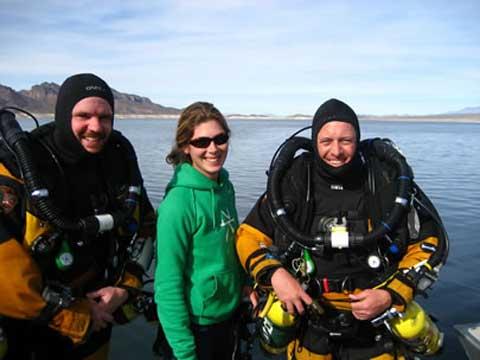Perhaps the best-kept secrets of our National Park System are found on more than three and a half million acres which are located underwater, and most of those areas are yet to be explored. Sound intriguing? If you're a diver, or know someone who is, this might be the opportunity of a lifetime.
The National Park Service and the Our World Underwater Scholarship Society have teamed up to create a Scientific Diving Internship, and applications are now being accepted.
According to the NPS' Submerged Resources Center, resources located beneath the water in parks include geysers on the bottom of Yellowstone Lake, coral reefs of the Dry Tortugas, steamers sunk in the frigid waters of Isle Royale in Lake Superior and the kelp forests of the Channel Islands—and only a fraction of those areas have been explored by divers.
Dave Conlin, acting chief of the Submerged Resources Center (SRC), notes
"The National Park Service has the oldest non-military diving program in the federal government and celebrates 50 years of work in parks this year. NPS divers work on more tasks in more diverse areas than just about any other diving agency in the world, and we are pleased to partner with the Our World Underwater Scholarship Society to bring these experiences to some of America's best and brightest young people."
This Scientific Diving Internship will last up to three months and is designed to allow a promising young person to experience the wide range of diving, research, public safety and ocean policy work that is happening in our national parks.
Applicants must be at least 20 years of age at the start of the internship and have current scuba certification with at least advanced open water certification and a minimum of 50 documented dives. They can work with the NPS Submerged Resources Center, one or more of the 72 NPS ocean parks, any available NPS dive team in the National Park System, or one of the numerous NPS centers and branches that are actively working on ocean policy.
"We are proud of our managers, diving rangers and scientists and believe that the National Park Service can provide exceptional life experiences for the talented and motivated young people who are Our World Underwater Scholars" said Conlin.
What kinds of experiences might be available to the intern?
Typical projects may include underwater archeology or filming/photography work with the Submerged Resources Center; biological assessments of coral reefs or kelp forests in places like Dry Tortugas National Park or Channel Islands; assistance with training at national training seminars for NPS divers; interpretation and outreach/education with parks like Biscayne National Park; or public safety diving with our law enforcement rangers at numerous parks throughout the system. In addition to fieldwork, the intern may have the opportunity to visit Washington DC to observe, first-hand, the crafting and implementation of NPS ocean policy and planning.
The SCR website has plenty of examples of the types of projects performed by the Center, which you can search by geographic area. For example,
Biscayne National Park is the largest marine park in the National Park System, with 95% of its 173,000 acres covered by water. The submerged lands of Biscayne are rich with archeological remains that document the cultural history of southern Florida and the Florida Keys. Archeological sites include the wrecks of many ships from foreign countries that comprise an international maritime heritage. The earliest identified shipwreck site is from the mid 18th century though some are suspected to date much earlier.
The SRC has been actively conducting underwater archeological work at Biscayne since 1975. Much of the work has focused on an 18th century shipwreck thought to be HMS Fowey, a British warship that sank in the park in 1748. The most complete documentation of the site took place between 1993 and 1995, after Hurricane Andrew had removed sediments from the ship's structure.
Additional information and an application form are available at this link. (Scroll down to the "National Park Service" link near the bottom of that page.) Applications must be postmarked by January 31, 2010.




Comments
I'm a Assistant Scuba Instructor,and Head Tech repairman at the world headquarters for Scuba Educators International-{The old YMCA scuba program}, We also operatate PDIC agency.
I'm very interested in becoming a National Park Diver! I've logged close to 3000 dives, most of witch are saltwater dives.
I work at one of the oldest scuba shops in the Midwest-Leaird's Underwater Service,my boss there has been in the bussness for 40 yrs. Please send me more info. Thanks